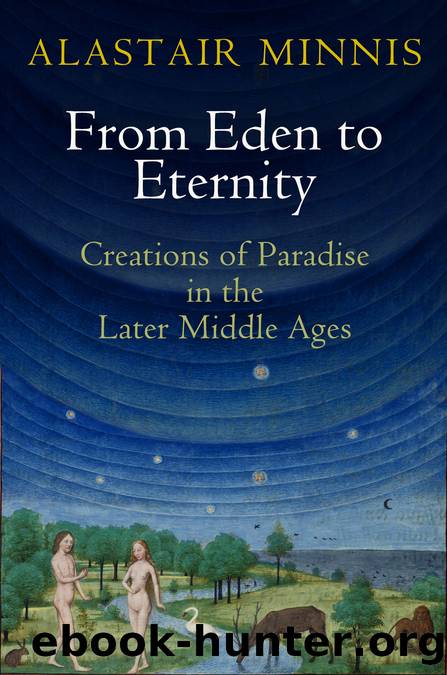From Eden to Eternity by Alastair Minnis;

Author:Alastair Minnis;
Language: eng
Format: epub
Publisher: Lightning Source Inc. (Tier 2)
Published: 2016-11-14T16:00:00+00:00
Resurrecting the Senses
Granted that the divine essence can be seen with the eyes of the mind, can it be seen with the eyes of the body?237 No, answers Aquinas. But corporeal sight will see it âas an object of indirect vision,â since the divine glory will be perceived through glorified bodies, particularly the body of Christ. Augustine is quoted as saying that in âthe bodily forms of the new heaven and the new earthâ we will âperceive God with total clarity and distinctness, everywhere present and governing all things, both material and spiritual.â238 While on the old earth we âsee the invisible things of God as understood by the things that are madeâ (Romans 1:20 again), there it will be like seeing men and not having to believe that they live but seeing that they live.239 Here is quite a dramatic foreshortening of the process of the via positiva. Whereas in the fallen world man needs creatures, and nature in general, to enable him to proceed from âthe things that are madeâ to âthe invisible things of God,â in heaven man will not need animal and plant life to perform that service240âand here is a major reason for their exclusion from the paradise of the blessed, as already explained. Through the intellect God will be seen immediately in His essence. And âthe carnal eye . . . will be unable to attain to this vision.â But corporeal sight will receive an appropriate solace (solatium congruens), because in the patria it will perceive God in the âbodily effectsâ of divinity (in suis effectibus corporalibus)âthat is, âespecially in Christâs flesh, and secondarily in the bodies of the blessed, and afterwards in all other bodies.â241 Aquinas probably has in mind the chapter in Augustineâs De civitate Dei that he had explicitly drawn on in the quaestio with which I began this paragraph.242 Offering alternative ways of understanding the role that bodily perception may play in the future paradise, there the saint speculated that perhaps âwe shall see Him in every body to which the keen vision of the eye of the spiritual body shall extend.â243 But Aquinasâs firm specification of the glorified bodies of Christ and the saints, together with any other corporeal form (presumably the heavenly bodies) which will exist in the homeland, as âbodily effectsâ by which the divine may be perceived, is an important affirmation of the presence, and the value, of the material.
Glorification will not damage or render inoperable the âcarnal eye,â render it incapable of sensation, Aquinas insists. Gloria non tollit naturam: glory does not destroy nature.244 Hence the human eye will retain its diaphanous character (diaphaneitas), with the intensification of clarity in its pupil rendering its sight keen rather than defective. Here sight, the noblest, strongest, and most subtle of the senses, is enthusiastically celebrated; its preeminence in the sensory experiences to be enjoyed by the glorified body affirmed. To go into more detail than Aquinas does at this point, it was believed that the human eyeball
Download
This site does not store any files on its server. We only index and link to content provided by other sites. Please contact the content providers to delete copyright contents if any and email us, we'll remove relevant links or contents immediately.
The Lost Art of Listening by Michael P. Nichols(6472)
Why I Am Not A Calvinist by Dr. Peter S. Ruckman(3769)
The Rosicrucians by Christopher McIntosh(3049)
Wicca: a guide for the solitary practitioner by Scott Cunningham(2704)
Signature in the Cell: DNA and the Evidence for Intelligent Design by Stephen C. Meyer(2501)
Real Sex by Lauren F. Winner(2474)
The Holy Spirit by Billy Graham(2416)
To Light a Sacred Flame by Silver RavenWolf(2353)
The End of Faith by Sam Harris(2287)
The Gnostic Gospels by Pagels Elaine(2026)
Nine Parts of Desire by Geraldine Brooks(2006)
Waking Up by Sam Harris(1958)
Heavens on Earth by Michael Shermer(1954)
Devil, The by Almond Philip C(1899)
Jesus by Paul Johnson(1887)
The God delusion by Richard Dawkins(1848)
Kundalini by Gopi Krishna(1824)
Chosen by God by R. C. Sproul(1760)
The Nature of Consciousness by Rupert Spira(1689)
